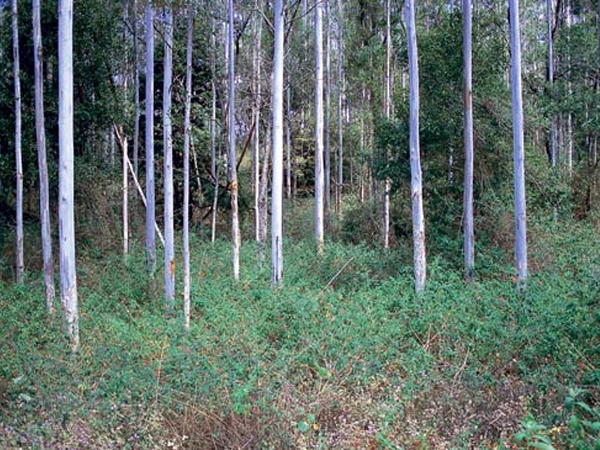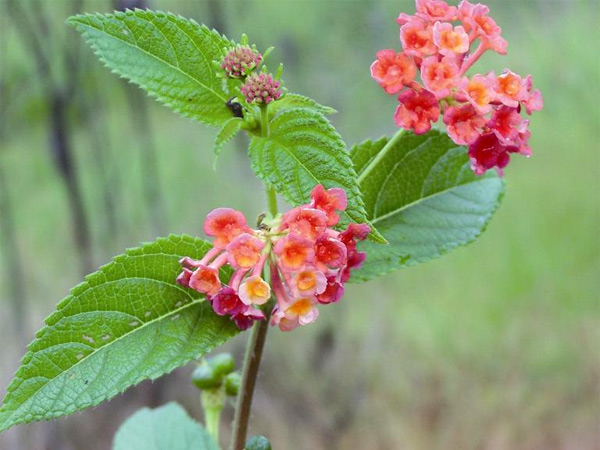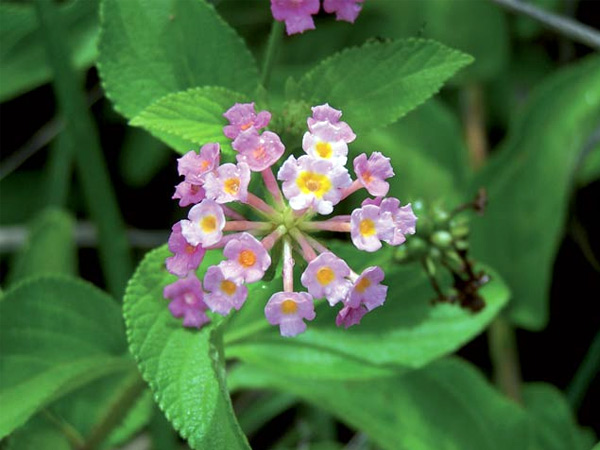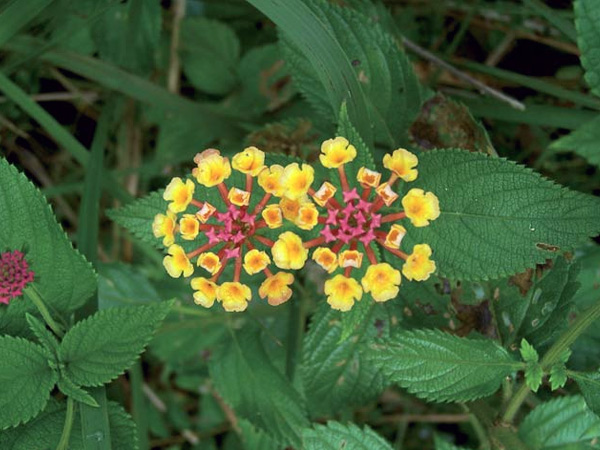Weeds
Lantana – Lantana camara
Lantana is a scrambling shrub with colourful flowers. It is a widespread weed in coastal areas.
Profile
How does this weed affect you?
- is poisonous to animals and humans
- invades native grassland and pastures
- invades eucalyptus and pine plantations
- fuels bushfires
- can restrict access to bushland and waterways
- costs land managers more than $22 million each year to control.
Lantana provides some shelter for native fauna.
Human poisoning
All parts of the plant are poisonous if eaten and can cause:
- vomiting
- diarrhoea
- weak muscles
- breathing problems
- death.
Touching lantana can irritate skin and eyes.
What to do if a person is poisoned:
- If the patient is unconscious, unresponsive or having difficulty breathing dial 000 or get to the emergency section of a hospital immediately.
- If the patient is conscious and responsive call the Poisons Information Centre on 13 11 26 or your doctor.
- If going to a hospital take a piece of the plant for identification.
Livestock poisoning
All types and parts of lantana are considered poisonous to stock. Red-flowered lantana is most dangerous. Stock poisoning is common. It happens most when new animals are introduced into lantana areas and there is no other feed. Cattle used to grazing lantana-infested land are less likely to eat it.
Early symptoms of lantana poisoning include:
- depression
- loss of appetite
- constipation
- frequent urination
- jaundice for 1 – 2 days
- inflamed eyes with a slight discharge.
- mouth area becoming inflamed, moist, and very sensitive, with a pink nose.
- bare skin becoming very sensitive to light, red and swollen, or may crack, turn black, and die.
Stock usually die 1 – 4 weeks after symptoms appear. Death is slow and painful from liver and kidney failure. Some animals have heart damage.
What does it look like?
Lantana is a usually a dense shrub, although it can drop its leaves in dry times. It usually grows from 2 – 4 m high but can scramble up into trees. There are five main types with different flower colours: pink, red, orange, white and pink-edged red. Red lantana has pricklier stems and darker green leaves than pink lantana.
Stems
- square
- with short, curved prickles.
Leaves
- rough and bright green on top
- hairy and pale green underneath
- with serrated edges
- fragrant when crushed
- in pairs, opposite each other on stems
- on a short stalk
- about 10 cm long
- 2 – 8 cm wide
- egg to spearhead-shaped.
Flowers
- in clusters
- different colours depending on the type of lantana, age and location. Flowers can be pink, red, orange, white and pink-edged red
- produced almost year round.
Fruit
- 6 – 8 mm in diameter
- round berries
- in a group
- green to start
- shiny, dark purple-black when ripe
- with one seed per fruit.
Roots
- shallow, mostly in the top 10 – 30 cm of soil.
Where is it found?
Lantana’s range extends from Bega Shire in southern NSW to Cape Melville in north Queensland. It is present on Lord Howe and Norfolk Islands. The main infestations are east of the Great Dividing Range in NSW and QLD.
Pink-edged red lantana grows on the:
- North Coast around Kempsey, south-east of Dorrigo, Bellingen, in the Coffs Harbour and Grafton areas
- Central Coast.
Red varieties grow on the North Coast, around Kempsey, Bellingen and Coffs Harbour.
Lantana is unlikely to invade new regions in NSW. It is increasing in density and invades new areas within its range.
Lantana comes from the tropical and subtropical regions of Central and South America. It was introduced to Australia in 1841 as an ornamental plant. By the 1860s it was common in Sydney and Brisbane.
What types of environment does it grow in?
Lantana can quickly colonise roadsides, power line and railway easements, river banks, fence-lines, forestry, pastures, open native woodlands and subtropical rainforest edges. Lantana can grow in steep, inaccessible areas. Lantana often invades disturbed areas where vegetation has been cleared. It’s less likely to grow in undisturbed bushland.
Lantana prefers:
- warm weather with more than 900 mm annual rainfall
- well-drained, fertile soils
- coastal areas
- altitudes up to 1000 m.
Lantana can survive periods of drought. It tolerates poor soils and sand and will grow on stony hillsides as long as moisture is available.
Lantana is slowed by:
- cold weather (it stops growing when temperatures are below 5°C)
- low light
- some soils (waterlogged conditions, heavy clays, salt-affected).
Distribution map
- NSW (image)
How does it spread?
Lantana was sold as an ornamental plant.
By seed
A single plant can produce up to 12,000 fruit (and seeds) in a year. Most seeds are spread by birds and some animals that eat the fruit. Lantana seed is more likely to germinate if it has been through the gut of a bird or mammal. Seeds are also spread by water, in soil, on machinery and garden waste.
About half of seeds remain viable for up to two years in dry conditions and some may survive for five years.
By plant parts
Lantana regrows after cutting back, even if cut to the base. Cut stems grow new roots when they contact damp soil.
More information
Control
Successful weed control takes time and follow up efforts to monitor and suppress weeds. A combination of control methods is usually needed.
To control lantana:
- gradually control sections of large infestations, starting at the edges (do as much at a time as you can follow up)
- dry or frosty periods are good times to work on mature lantana plants
- treat regrowth or seedlings before they are 1 m high
- control young plants before they are a year old to prevent new fruit and seeds
- in summer, look for a flush of seedlings after rain, and kill the seedlings 1 – 3 after the rain event (lantana seeds can germinate year round but peak after summer rain).
- 1 – 3 months after clearing, burning or cultivation, look for regrowth or new seedlings and control them.
- 3 – 6 months after the end of a dry spell, look for dry lantana that appeared dead reshooting from the base, and control the regrowth
- in spring, look for plants that reshoot after frost damage, and control the survivors.
Physical removal
When: year round, after rain when soil is moist.
Follow-up: within 3 to 6 months.
Hand pulling can work on small infestations, isolated plants and in steep areas that machinery cannot access. The best time is after rain when soil is moist. Wear gloves when hand pulling. Grub out roots with a mattock or hoe, then roll and haul the stems and roots away. Remove the roots and stems or the lantana will regrow.
Bulldozing or slashing can remove large bushes, and help access through infestations. Avoid disturbing large areas at any one time to avoid leaving large areas of bare ground, risking soil erosion. Revegetate and monitor bare areas for regrowth.
Slashing can be used to suppress and contain large infestations. It won’t kill the plants and follow up control of regrowth is needed. Reducing the height and density of thickets allows other treatments.
Cattle familiar with lantana can break up thickets and help create access tracks for other controls. Watch for any signs of poisoning (see Livestock poisoning above).
Pasture management and trampling by cattle
Maintaining good pasture cover helps stop lantana seedlings from growing.
Fire
Fire can reduce the height and density of lantana. Fire rarely kills lantana, and plants soon recover. Risks of using fire include:
- destroying desirable vegetation
- exposing soil and causing erosion.
Biological control
Since 1914, 32 biological control agents (insects and diseases) have been introduced to help control lantana. 19 have become established and help to reduce lantana in some areas.
Even if biological control agents are helping to reduce your lantana, you can still use most other control methods to reduce it more. Spraying the leaves with herbicide won’t work on plants that are affected by biological control agents, but you can still use cut-stump or basal bark methods of chemical control, or physical removal (see above and below). Burning will only be effective if there is enough fuel (i.e. enough dry leaves left on the lantana and surrounding vegetation).
There is no need to keep an area of lantana for the sake of a biological control agent.
Disease
The lantana rust (Prospodium tuberculatum) was introduced from Brazil in 2001. It attacks the pink-flowering Lantana. It appears to tolerate a range of climatic conditions.
Insects
Leaf mining beetles Uroplata girardi and Octotoma scabripennis are most effective. Larvae of both these insects feed on lantana leaves. This slows growth and reduces flowering.
The leafsucking bug Teleonemia scrupulosa also feeds on leaves.
The lantana seed fly, Ophiomyia lantanae, attacks flowers, fruit and seed. Adults feed on the flowers. Larvae feed on fruits and seeds.
These insects have already spread throughout areas they will colonise. Look for bugs or larvae on both sides of the leaves, or insects on the flowers, fruit or stems. These insects may cause damage at some times of the year and no damage at other times.
Chemical control
Pink flowered lantana is easier to control with herbicide. Red flowered varieties are harder to kill.
Spraying leaves
Small plants less than 2 m can be sprayed at any time of the year as long as they are actively growing. Stressed plants don’t take up much herbicide. Treat regrowth from burning, cutting, slashing or frost when plants are 30 cm to 1 m high.
Spray mature lantana (>2 m high) between February and the first frost.
Early morning or late afternoon is the best time to spray during Autumn.
Gas or splatter-gun
Splatter-guns use small amounts of highly concentrated herbicide. A five-litre bottle of mixed herbicide should cover about 0.2 hectares of lantana. The splatter gun:
- works best on dense infestations at least 300 mm high
- limits off-target plant damage
- is good for hard-to-access and steep areas
- can be used year round if plants are actively growing, but works best during summer
- is cheaper than traditional foliar spray methods.
Spray before 10 am and after 3 pm when it’s cool. Angle the gun at 45 degrees and spray an arc over the top of the plant and down the front face. Apply 2 squirt lines per half a metre of plant height. The amount to apply will depend on the herbicide concentration. Do not spray until herbicide runs off.
Do not use the splatter-gun:
- in wet weather
- when there is water or dew on the plants
- on spindly lantana regrowth.
Spraying stems
Applying herbicide to the stems is called ‘basal barking’. It’s effective at any time of year. Mix herbicide with diesel. Apply around all stems from the ground up to 30 cm high by:
- spraying at low-pressure
- painting on with a brush.
Cut stump method
Cut stems off at about 15 cm from the ground. Apply herbicide to the cut surface of the stump within 15 seconds. Treat every cut stem because lantana regrows vigorously from untreated stems.
Similar natives that are not weeds
An introduced species, invasive or non-native species is a species living outside its native distributional range, but which has arrived there by human activity, either deliberate or accidental. These organisms have often been introduced to areas in which they are not native, usually without much regard to the harm that could result.
In many cases there are native plant species that resemble the introduced variety. If you like the look of the introduced species, why not consider an Australian native species with similar aesthetics instead. You will not only have a beautiful garden, you will also be doing something positive for the local flora and fauna.
-
Trema aspera – Native Peach
Trema aspera – Native Peach is a fast growing pioneer species to 3m with slender spreading branches. Tiny green flowers, small black fruit avidly sought by a variety of birds. Adapts to most well drained situations.







